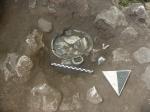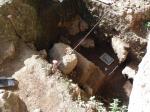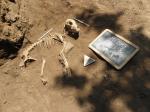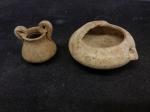Summary (English)
This season, the excavations at Santa Maria Agnano continued in last year’s areas and two new trenches were opened. The Holocene and Pleistocene levels underlying the rock face of the shelter in area H-P were explored, as were the sectors identified as “Scavo esterno”, relating to the Palaeo-Epipaleolithic stratigraphy, areas L-M on the lower terrace where Hellenistic layers are attested, and areas Re and T on the lower terrace and in the western cavity.
This year, the brief excavation in area H-P revealed a sequence of ill-defined Epipalaeolithic-Mesolithic occupations followed by periodic, but not isolated episodes, represented by cult practices associated with the arrangement of stones with linear incisions.
A new trench, Area Re, was opened in the eastern zone of the sanctuary. The removal of the humus revealed a pit (or cut) containing the burial of a dog (post-dating the 3rd century B.C.). The deposition was part of a ritual for the purification and sacralising of the area, as well as for protecting the underlying votive areas.
The dog burial cut US 5006, an earlier occupation layer dated by pottery with painted bands and black glaze ware. A preliminary analysis of the forms of the plain ware pottery suggest parallels with 6th-3rd century B.C. types, a date that fits with the black glaze pottery and the ritual cooking wares relating to a final phase of use of the sacred area.
The removal of the layer below the deposition revealed an unusual stratigraphic situation: a circle of stones (_bothros_) still containing the offering of a tall-footed black glaze kylix, a bronze coin from Arpi (of the bull/horse type) and a circular bronze pendent. Below a moderately compact layer of stones, new and substantial occupation evidence came to light, datable to the second half of the 4th century with layers rich in pottery and tile fragments. The layer, c. 25-30 cm deep, seemed to be a deliberate dump of votive and cult material from the sanctuary. The nature of this layer was confirmed by finds of a fragment of Messapian inscription on stone, of antefixes and bronze laminae. The subsequent layers showed a gradual, but clear decrease in the use of the area. It is probable that in the earliest phases (preceding the mid 4th century B.C.), this was a marginal area of the sanctuary.
At depth of about 180 cm from ground level, an installation of large and medium sized represented the reorganisation of the area.The decision was made to open a new trench with the aim of understanding the occupation and votive dynamics inside the west grotto.
Given the difficulty and delicate nature of the intervention, it was decided to prepare the area for future excavation, cleaning and laying out a trench of c. 3 × 4 m and only removing the first layer.
A number of white-painted intact lamps (4th-3rd century B.C.) were found indicating the practice of nocturnal rituals relating to Chthonic divinities. A column fragment and a large stone block with moulding and decoration were also found, although their dating is uncertain.
- Donato Coppola – Università degli Studi di Bari “Aldo Moro”
- Nicola de Pinto - Università degli Studi di Bari “Aldo Moro”
Director
- Donato Coppola – Università degli Studi di Bari “Aldo Moro”
Team
- Henry Baills - Musée de Tautavel, Centre Européen de Préhistoire
- Nicola de Pinto - Università degli Studi di Bari “Aldo Moro”
- Martine Dewailly - Ecole Française de Rome
- Michele Pellegrino - Università degli Studi di Bari “Aldo Moro”
Research Body
- Università degli Studi di Bari “Aldo Moro”
Funding Body
- Comune di Ostuni, Museo di Civiltà Preclassiche della Murgia meridionale






![Download [PDF]](/excavation/skins/fasti/images/results/download_sml.png)


